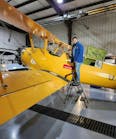Sydney Students Simulate Flight of NASA’s Ingenuity Mars Helicopter
The NASA Ingenuity Mars helicopter was scheduled to lift off at 17:30 AEDT, with data set to be received by Earth three hours later.
University of Sydney students have simulated the “Mars-copter’s” first flight. They hope their computational models will be used by NASA to better understand flow interactions between the rotorcraft and the Mars Perseverance Rover, as well as between the rotorcraft and the terrain on Mars.
Students Shaka Chu and Jack Park from the School of Aerospace, Mechanical and Mechatronic Engineering, along with Associate Professor Ben Thornber, have led a team of students to create aerodynamic simulations of the Ingenuity Mars helicopter.
They say their approach, which involves computational fluid dynamics, is essential to understanding how spacecraft fly and operate, as it is impossible to mimic all space conditions on Earth.
“Ingenuity’s test flight will be an important milestone in space exploration as it will demonstrate the efficacy of helicopter technology on Mars, which has conditions quite different to Earth,” said Chu.
“On Earth, helicopters rely on lift created by the fast spinning of their rotors, however they operate under specific atmospheric and gravitational conditions,” said Chu.
“On Mars, flying conditions are quite different, not only is the atmosphere composed predominantly of carbon dioxide, but its gravitational force is much less than Earth’s. Another challenge is flying the Mars-copter without creating a large dust plume, which would diminish visibility,” said Park.
“There are no humans or engineers on Mars, which is why computational engineering is so important,” said Park.
“Computations including the complex geometry of the rover are enormously challenging, but thanks to our new computational models we can deliver important insights to help understand and advance upon the flight performance of this unique helicopter,” said Thornber.

